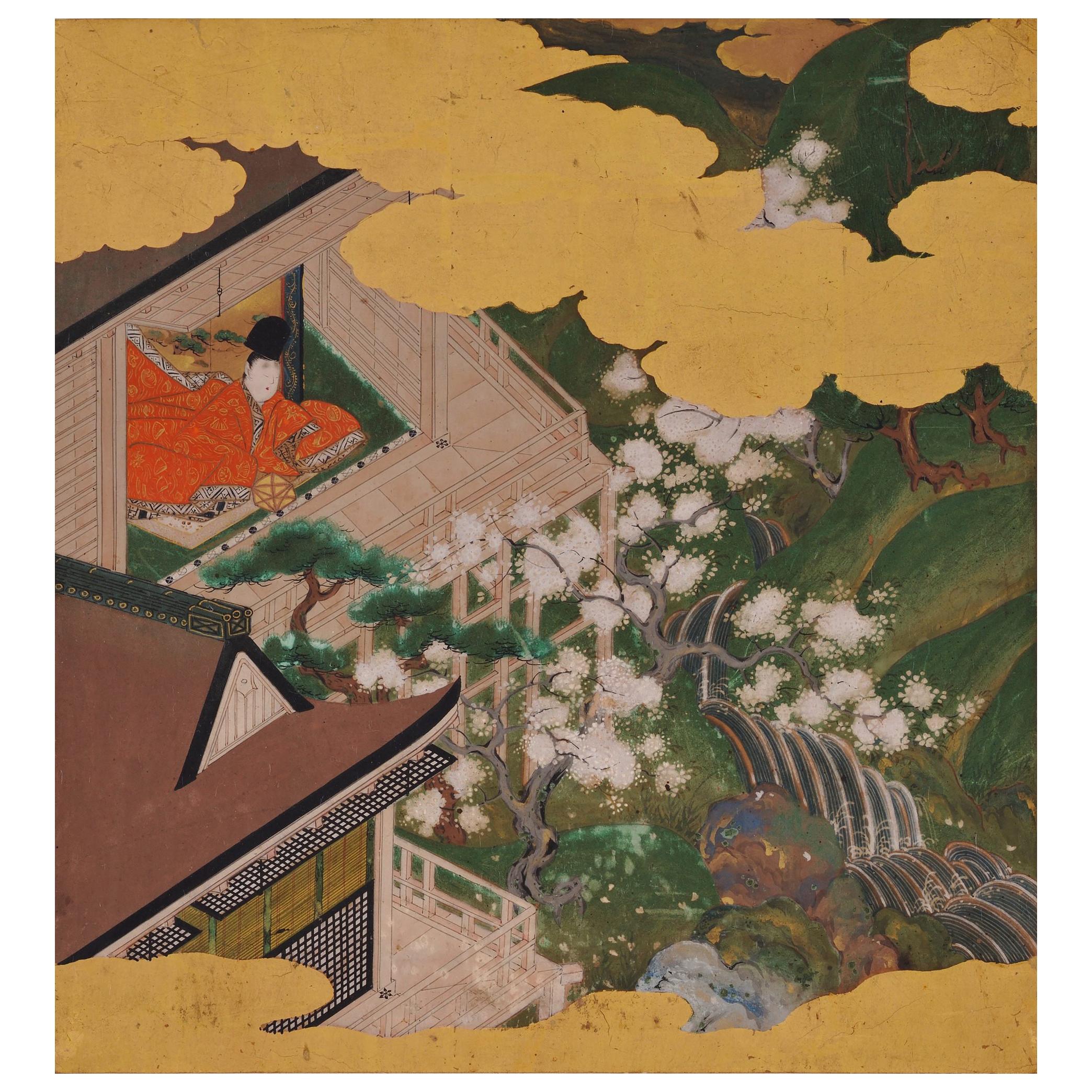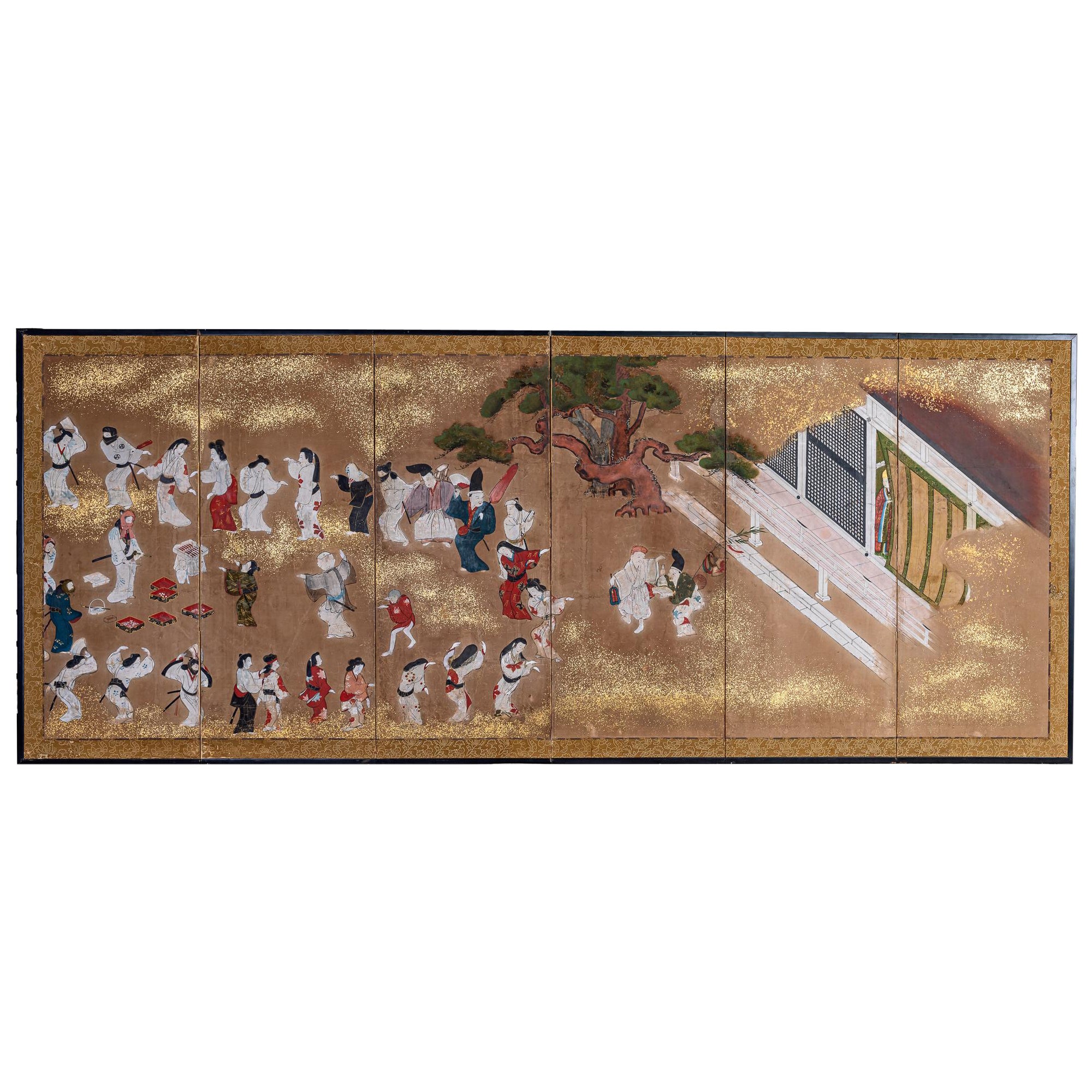Items Similar to Japanese Screen Painting, Circa 1700 'Tales of Ise' by Tosa Mitsusuke
Want more images or videos?
Request additional images or videos from the seller
1 of 5
Japanese Screen Painting, Circa 1700 'Tales of Ise' by Tosa Mitsusuke
About the Item
A six-fold Japanese screen by Tosa Mitsusuke (1675-1710), Japan 17th-18th century, Edo period.
The signature reads Shoroku-i ge Tosa sa Konoe Shogen Mitsusuke Hiitsu. The seal is illegible.
Ink, pigments and gold-leaf on paper.
This small screen displays seven narratives of the Tale of Ise, each meticulously brushed with rich pigments on a gold-leaf background. Artists of the Tosa school painted for the imperial court and aristocratic patrons, their subject matter most commonly based on themes from Japanese literature. There is no set order for reading the screen. Rather, the viewer is encouraged to wander at leisure, recalling the scenes pictured and the sentiments they evoke.
The Tales of Ise are presumed to detail episodes in the life of Ariwara no Narihira (825-880), a celebrated poet and nobleman of early Heian court society. First appearing in the tenth century, the Tales are a compilation of more than one hundred brief episodes that culminate in one or more poems. Poetry was central to the cultural life of Japanese aristocracy and its influence peaked in the Heian period. In the Tales of Ise, the prose is designed primarily to provide settings for the poems, which are characterised by an appreciation of nature’s beauty and a pervasive awareness of life’s impermanence.
Tosa Mitsusuke was the 18th head of the Tosa school. He is the son of Tosa Mitsunari (1646-1710). Successive heads of the Tosa school served the emperors as Edokoro-Azukari (official painters for the Imperial Palace). This title was passed to Mitsusuke, from his father, in 1696. In 1709, it is recorded that Mitsusuke, with Kano Tsunenobu, painted sliding doors in the Imperial Palace and the Sento Palace.
Dimensions:
Screen – H. 28” x W. 91” (66 cm by 232 cm).
- Creator:Tosa Mitsusuke 1 (Artist)
- Dimensions:Height: 28 in (71.12 cm)Width: 91 in (231.14 cm)Depth: 1 in (2.54 cm)
- Style:Edo (Of the Period)
- Materials and Techniques:
- Place of Origin:
- Period:Late 17th Century
- Date of Manufacture:circa 1700
- Condition:Refinished. Wear consistent with age and use. Conservation and full re-mounting undertaken in Kyoto utilizing traditional techniques and craftsmen.
- Seller Location:Kyoto, JP
- Reference Number:1stDibs: LU247236417133
About the Seller
5.0
Recognized Seller
These prestigious sellers are industry leaders and represent the highest echelon for item quality and design.
Gold Seller
These expertly vetted sellers are highly rated and consistently exceed customer expectations.
Established in 2001
1stDibs seller since 2016
Typical response time: 6 hours
- ShippingRetrieving quote...Ships From: Kyoto, Japan
- Return PolicyA return for this item may be initiated within 10 days of delivery.
More From This SellerView All
- Japanese Painting, 17th Century, Tale of Genji, Tosa SchoolLocated in Kyoto, JPIllustration to an unidentified chapter of the Tale of Genji (Genji Monogatari) Tosa School (second half of the 17th Century) Ink, pigment, gofun and...Category
Antique Late 17th Century Japanese Edo Paintings and Screens
MaterialsGold Leaf
- Japanese Screen Painting, circa 1700 'Horses' by Kano TanshinLocated in Kyoto, JPHorses Kano Tanshin Morimasa (1653-1718) Two-panel tea-ceremony Japanese screen or furosaki Ink on gold leaf, late 17th-early 18th century Measures: H 55 cm x W 182 cm The Kano school was closely aligned with the warrior class in Japan. The samurai, who lived in a closed and rigid hierarchical society established by the Shogunate, were drawn to the energy and freedom horses symbolize; Kano school artists commonly depicted the equine creatures as they are here, in unfettered and carefree family groups. China originally introduced horse paintings to Japan; the works typically focused on capturing the essence of horses in their various environments and often involved integrating human figures into the images. Kano Tanshin Morimasa (1653-1718) was the son of Kano Tanyu...Category
Antique 1690s Japanese Edo Paintings and Screens
MaterialsGold Leaf
- Japanese Painting, 17th Century, Tale of Genji, Makibashira, Tosa SchoolLocated in Kyoto, JPThe Handsome Pillar (Makibashira), Illustration to Chapter 31 of the Tale of Genji (Genji Monogatari) Tosa School (second half of the 17th Century) I...Category
Antique Late 17th Century Japanese Edo Paintings and Screens
MaterialsGold Leaf
- Japanese Painting, 17th Century, Tale of Genji, Fujibakama, Tosa SchoolLocated in Kyoto, JPPurple Trousers (Fujibakama), Illustration to Chapter 30 of the Tale of Genji (Genji Monogatari) Tosa School (second half of the 17th century) Ink, ...Category
Antique Late 17th Century Japanese Edo Paintings and Screens
MaterialsGold Leaf
- Circa 1700 Japanese Screen Pair, Cranes & Pines, Kyoto Kano SchoolLocated in Kyoto, JPPines and Cranes Anonymous. Kyoto Kano School. Late 17th/early 18th centuries, circa 1700. Pair of six-panel Japanese folding screens. Ink, gofun, pigment and gold leaf on paper. This bold composition presents two pine trees extending to the left and right across a gold leaf background. One tree is silhouetted against a green ground, golden clouds obscuring its true size, the other stretches across a stylized waterway. The pines are paired with Manchurian cranes with red crests and snow white plumage. Both have been highly auspicious motifs in East Asia since Chinese antiquity. Here the artist utilized fluid and instinctive ink brushstrokes to define the trunk, branches and tail feathers, in strong contrast to the precision and sharp angularity of the crane’s legs and beaks. The adoption of this vast metallic painting support required an unerring sense of design and composition, so that the negative space surrounding motifs could imply context for the otherwise floating pictorial elements. The brushwork detailing the trunks of the pines, the exaggerated dimensions of the pine trees and the strength and dynamism of the composition are all reminiscent of Kano Eitoku...Category
Antique Late 17th Century Japanese Edo Paintings and Screens
MaterialsGold Leaf
- Japanese Screen Painting, Early 19th Century, Autumn Flowers by Sakai HoitsuLocated in Kyoto, JPA two-fold Japanese screen by the Rimpa school artist Sakai Hoitsu (1761-1828), Japan, 19th century, Edo period. This small Japanese folding screen pai...Category
Antique Early 19th Century Japanese Edo Paintings and Screens
MaterialsWood, Silk
You May Also Like
- Japanese Six Panel Screen: Tosa School Painting of Theatre SceneLocated in Hudson, NYwith thought to be Izumo no Okuni (1578-1613). Mineral pigments and gold dust on mulberry paper with silk brocade border.Category
Antique 18th Century Japanese Paintings and Screens
MaterialsGold
- Japanese Two-Panel Screen Ink Painting of Palm Trees on PaperLocated in Hudson, NYJapanese two-panel screen: ink painting of Palm Trees on paper, Edo period (1787) beautiful painting of Japanese windmill palm trees. Ink paint...Category
Antique 18th Century Japanese Edo Paintings and Screens
MaterialsPaper, Silk, Wood
- Meiji Era Japanese Two Panel Hand Painted Wood Table Screen Tale of GenjiLocated in Studio City, CAA Meiji era Japanese two-panel wood screen, with illustrated images from The Tale of Genji that are exquisitely painted directly on wood with fine detail and precision, accented with scattered 24k gold leaf specks in cloud forms, rendered in the manner of Heian period...Category
Antique 19th Century Japanese Meiji Paintings and Screens
MaterialsGold Leaf
- Tosa School ca 1700 Scene Edo Period Scroll Japan 17/18c Artist Tosa MitsunariLocated in Amsterdam, Noord HollandAround the middle of the Edo period, say to have been drawn in Tosa Mitsunari of the hands of the Tosa School, the Heian period of person (noble?) Is watching the birds fly the gard...Category
Antique 18th Century Japanese Edo Paintings and Screens
MaterialsSilk
- Japanese Two Panel Screen Ink Painting of Banana Leaves on Mulberry PaperLocated in Hudson, NYEdo period (dated 1787) beautiful painting of unfurling palm leaves with romping puppies in the background. Ink painting (sumi-e) on mulberry paper. Signature reads: Okyo. Calligraph...Category
Antique Late 18th Century Japanese Edo Paintings and Screens
MaterialsPaper
- Japanese Six Panel Screen Battle of Uji BridgeLocated in Hudson, NYThe first battle at Uji was in 1180 and was the beginning of the Heike Wars. This screen depicts a famous scene from the Heike Wars. Two Heike generals, Sasaki Takatsuna and Kajiwa...Category
Antique Early 19th Century Japanese Edo Paintings and Screens
MaterialsGold Leaf
Recently Viewed
View AllMore Ways To Browse
Gilt Screen
Screen Doors Used
Six Fold
Japanese Emperor
Emperor Japan
Emperor Painting
Used Screen Doors
Japanese Brush
Japanese Brushes
Japanese Folding Screen Screen
Japanese Sliding
Asian Painting On Gold Leaf
Edo Screen
Gold Folding Screen
Edo Period Japanese Painting
Imperial Palace
Small Wood Screen
Japanese Edo Screens





